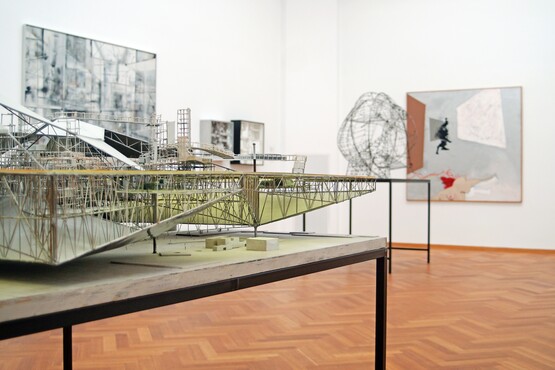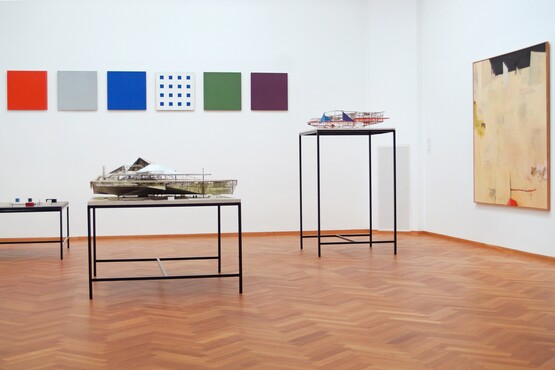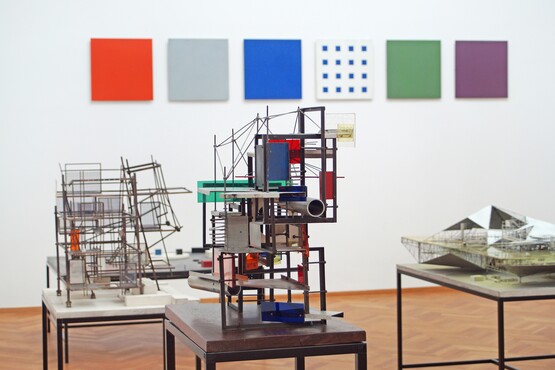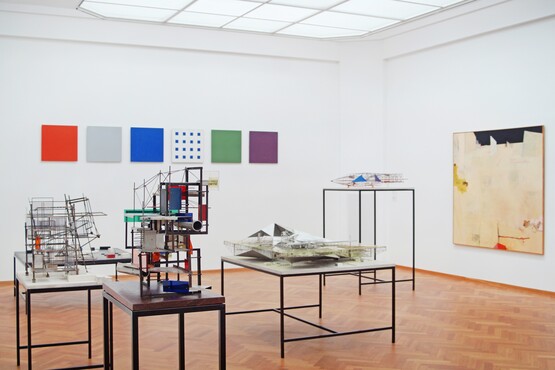Ontdek de collectie
Kunstmuseum Den Haag has a treasure chamber of over 160.000 pieces of art. Here we work on making the highlights from this collection available online.
Constant’s New Babylon on permanent display
The Kunstmuseum's permanent Discover the Modern exhibit now includes a new display of the finest architectural models and paintings from Constant’s New Babylon project. In 2015, working hand in hand with the Fondation Constant, the Gemeentemuseum Den Haag organized the biggest ever exhibition on New Babylon. It was held first at Madrid’s Museo Nacional Centro de Arte Reina Sofía and transferred to The Hague in the summer of 2016, with a major publication being issued to accompany it. The new permanent display includes the two Dioramas that the Kunstmuseum has recently purchased with the assistance of the Rembrandt Society and the Mondriaan Fund.
The Kunstmuseum has the biggest New Babylon collection in the world, comprising 19 architectural models, 72 drawings, 48 prints and 4 paintings. In addition, the museum’s holdings include a large selection of Constant’s works from the Cobra period and from the post-New Babylon period.
Constant’s New Babylon
In 1956, Dutch artist Constant Nieuwenhuys (Amsterdam, 1920 - 2005) started work on a vast architectural and urban planning project that he called New Babylon. He worked on it non-stop for almost twenty years, expressing his ideas not only in architectural models, topographical maps, paintings, drawings and prints, but also in films, manifestos, texts and lectures. In 2004 he said, “New Babylon is not a model that should be imitated, but rather an illustration of a way of life in a hypothesized society. This way of life is nomadic in principle. People travel the world leaving tracks that can form a network. A city as a network. New Babylon is a nomadic city. Nothing is fixed.”
In the 1950s, Constant foresaw that the ever-increasing automation of society would give people both increasing amounts of leisure time and the ability to travel with growing ease and speed over greater distances using the then rapidly expanding road and air transport networks. “New Babylon is a gigantic labyrinthine complex raised above the earth on tall pillars. All forms of transport circulate below it. The various tiers of the city can be reached via lifts and stairs and are almost entirely roofed-in and climate-controlled. With their many levels and terraces, they form a vast multi-layered space that constantly offers new surprises as a result of its functional flexibility, climatic variability and light and sound effects. New Babylonians can wander around like modern nomads, in search of new experiences and unknown sensations.” New Babylon consists of various interlinking sectors, has no predetermined dimensions and is designed for continuing growth. The roofed-in urban network is eventually to extend over the entire planet. In his New Babylon project, Constant assumes the existence of an alternative, fully automated society in which human labour has become unnecessary. The traditional mainstays of life – home, work, recreation and transport – are all replaced by creativity. The ever-changing form of New Babylon’s sectors will be determined by the city’s inhabitants, Homo Ludens (‘man at play’), a complete contrast to the model citizens of the past, with their pre-programmed ideas of happiness. The New Babylonians were to lead a constantly nomadic and creative existence, joining with others in the exploration of their own individual creativity.
© Foto's: A.M. Minnaard fotografie








